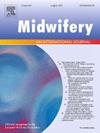求助PDF
{"title":"Using digital technologies and applications in midwifery practice in Belgium: A descriptive cross-sectional study","authors":"Ayse Akalin , Florence D'haenens , Joeri Vermeulen , Sandra Tricas-Sauras , Dorien Lanssens","doi":"10.1016/j.midw.2024.104218","DOIUrl":null,"url":null,"abstract":"<div><h3>Introduction</h3><div>Over the past two decades, there has been a dramatic increase in the use of digital technologies within healthcare and also in midwifery. However, scarce literature exist on the use of digital technologies and applications in midwifery practice particularly in the Belgian setting.</div></div><div><h3>Aim</h3><div>To map the use of digital technologies and applications by midwives in various settings, encompassing hospitals, primary care, and educational institutions in Belgium.</div></div><div><h3>Methods</h3><div>A descriptive cross-sectional design was used to collect data via an online questionnaire targeting at midwives working in the Flemish region, Walloon region, or Brussels-Capital region. Midwives were either Dutch-speaking or French-speaking (<em>n</em> = 212). The semi-structured questionnaire addressed three domains: (1) socio-demographics, (2) employment information (3) the use of digital technology, including the level of comfort with technology. Qualtrics© program was used for managing data and SPSS v28.0© for data analysis using descriptive statistics, Chi² analysis, and independent sample t-test. The study adhered to the Strengthening the Reporting of Observational Studies in Epidemiology reporting guidelines.</div></div><div><h3>Results</h3><div>Among respondents, 58% reported the use of digital technologies and applications, with electronic health records (89.6%), electronic prescriptions (65.6%), and remote patient monitoring (51.2%) commonly utilized. Sensor technology (7.2%), mixed care (3.8%), care robots (2.5%), and wearable devices (1.9%) were very rarely used. The target groups for these digital technologies and applications generally encompass all stages of the perinatal period. Midwives felt overall highly confident with these technologies. Younger participants and those with a Master's or PhD degree exhibited greater comfort scores in digital technology use. No significant relationships were observed between socio-demographic characteristics and the adoption of digital technology.</div></div><div><h3>Conclusion</h3><div>The results highlight the potential for incorporating digital technologies and applications into various midwifery care settings. Addressing barriers and enhancing usability can optimize technology integration, contributing to personalized high-quality care, ultimately improving perinatal health outcomes.</div></div>","PeriodicalId":18495,"journal":{"name":"Midwifery","volume":"140 ","pages":"Article 104218"},"PeriodicalIF":2.6000,"publicationDate":"2024-10-19","publicationTypes":"Journal Article","fieldsOfStudy":null,"isOpenAccess":false,"openAccessPdf":"","citationCount":"0","resultStr":null,"platform":"Semanticscholar","paperid":null,"PeriodicalName":"Midwifery","FirstCategoryId":"3","ListUrlMain":"https://www.sciencedirect.com/science/article/pii/S0266613824003012","RegionNum":3,"RegionCategory":"医学","ArticlePicture":[],"TitleCN":null,"AbstractTextCN":null,"PMCID":null,"EPubDate":"","PubModel":"","JCR":"Q1","JCRName":"NURSING","Score":null,"Total":0}
引用次数: 0
引用
批量引用
Abstract
Introduction Over the past two decades, there has been a dramatic increase in the use of digital technologies within healthcare and also in midwifery. However, scarce literature exist on the use of digital technologies and applications in midwifery practice particularly in the Belgian setting.
Aim To map the use of digital technologies and applications by midwives in various settings, encompassing hospitals, primary care, and educational institutions in Belgium.
Methods A descriptive cross-sectional design was used to collect data via an online questionnaire targeting at midwives working in the Flemish region, Walloon region, or Brussels-Capital region. Midwives were either Dutch-speaking or French-speaking (n = 212). The semi-structured questionnaire addressed three domains: (1) socio-demographics, (2) employment information (3) the use of digital technology, including the level of comfort with technology. Qualtrics© program was used for managing data and SPSS v28.0© for data analysis using descriptive statistics, Chi² analysis, and independent sample t-test. The study adhered to the Strengthening the Reporting of Observational Studies in Epidemiology reporting guidelines.
Results Among respondents, 58% reported the use of digital technologies and applications, with electronic health records (89.6%), electronic prescriptions (65.6%), and remote patient monitoring (51.2%) commonly utilized. Sensor technology (7.2%), mixed care (3.8%), care robots (2.5%), and wearable devices (1.9%) were very rarely used. The target groups for these digital technologies and applications generally encompass all stages of the perinatal period. Midwives felt overall highly confident with these technologies. Younger participants and those with a Master's or PhD degree exhibited greater comfort scores in digital technology use. No significant relationships were observed between socio-demographic characteristics and the adoption of digital technology.
Conclusion The results highlight the potential for incorporating digital technologies and applications into various midwifery care settings. Addressing barriers and enhancing usability can optimize technology integration, contributing to personalized high-quality care, ultimately improving perinatal health outcomes.
在比利时的助产实践中使用数字技术和应用程序:一项描述性横断面研究。
导言:在过去的二十年里,数字技术在医疗保健和助产领域的应用急剧增加。然而,有关助产士在助产实践中使用数字技术和应用的文献却很少,尤其是在比利时的助产实践中。目的:绘制助产士在各种环境中使用数字技术和应用的地图,包括比利时的医院、初级保健和教育机构:方法:采用描述性横断面设计,通过在线调查问卷收集数据,调查对象为在弗拉芒大区、瓦隆大区或布鲁塞尔首都大区工作的助产士。助产士要么讲荷兰语,要么讲法语(n = 212)。半结构式问卷涉及三个方面:(1)社会人口统计;(2)就业信息;(3)数字技术的使用,包括对技术的舒适程度。研究使用 Qualtrics© 程序管理数据,并使用 SPSS v28.0© 进行数据分析,包括描述性统计、Chi² 分析和独立样本 t 检验。研究遵循了《加强流行病学中观察性研究的报告指南》:在受访者中,58%的人表示使用过数字技术和应用,其中电子健康记录(89.6%)、电子处方(65.6%)和远程患者监护(51.2%)得到了普遍使用。很少使用传感器技术(7.2%)、混合护理(3.8%)、护理机器人(2.5%)和可穿戴设备(1.9%)。这些数字技术和应用的目标群体一般包括围产期的各个阶段。助产士总体上对这些技术非常有信心。年轻的参与者和拥有硕士或博士学位的参与者在数字技术使用方面表现出更高的舒适度。社会人口特征与数字技术的采用之间没有明显的关系:研究结果凸显了将数字技术和应用融入各种助产护理环境的潜力。解决障碍和提高可用性可以优化技术整合,促进个性化的高质量护理,最终改善围产期健康结果。
本文章由计算机程序翻译,如有差异,请以英文原文为准。


